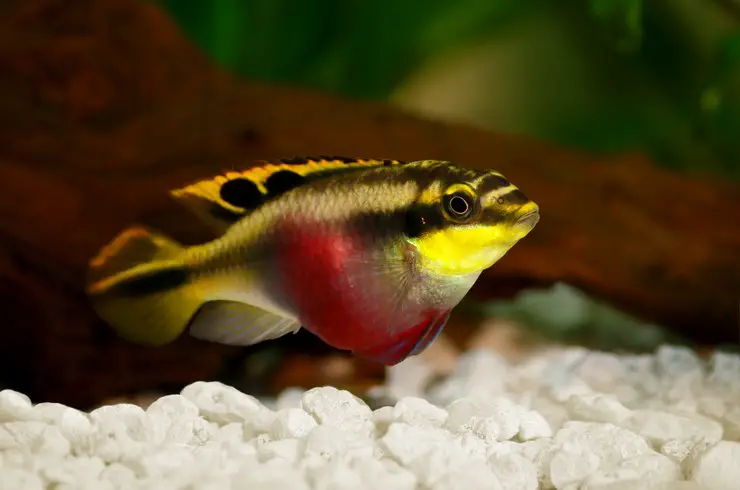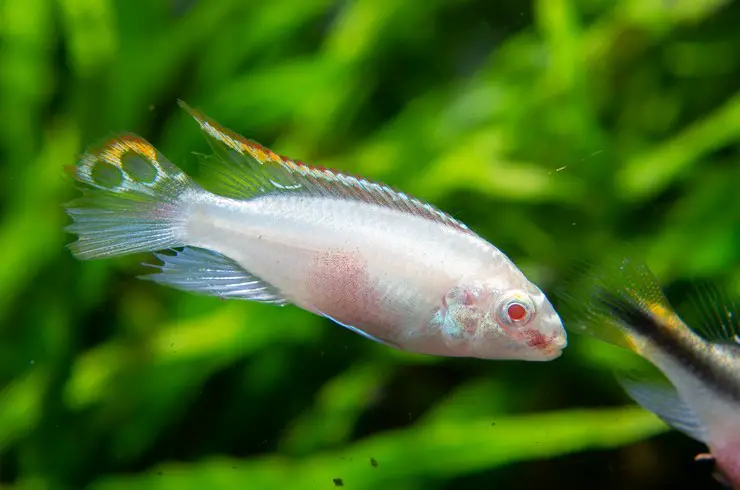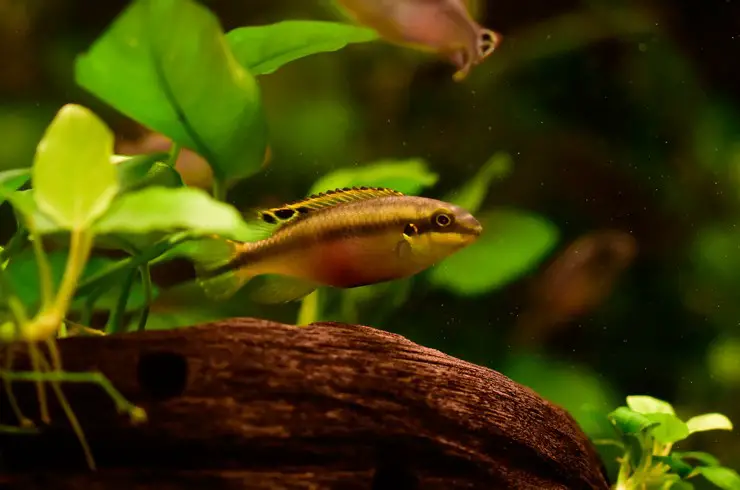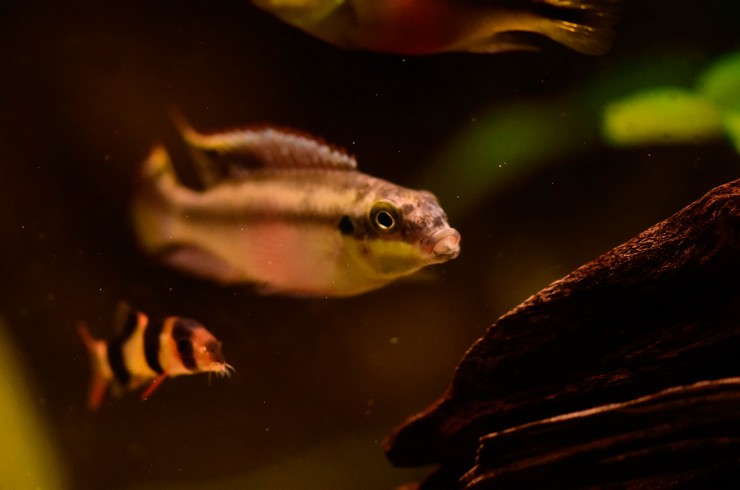Among the vast family of cichlids, the so-called dwarf cichlids stand apart, that is, species whose adult size does not exceed 10 cm. They are found both on the American and African continents. In their color, as well as in the level of intelligence, they are in no way inferior to their larger counterparts. But they do not require huge aquariums and are often able to get along even with peaceful medium-sized fish. A guest from tropical Africa – the bright and active pelvicachromis pulcher – will be discussed in our article.
General information
Pelvicachromis pulcher (Pelvicachromis pulcher) is a freshwater ray-finned fish from the Tsikhlov family. Its second popular name is the parrot cichlid (not to be confused with the red hybrid parrot!). The fish got such a nickname for the variegated coloration, reminiscent of the plumage of these bright birds, and the unusual shape of the muzzle, slightly curved downward like a beak. Pelvikachromis are hardy fish, it is interesting to watch them, it is not for nothing that this species has been kept and bred by aquarists for several centuries.
Pelvicachromis have a bright and variegated color. The back of the fish is brown, the belly has a cherry-colored spot, the lower part of the head is golden. A wide dark strip stretches across the entire body. The scales on the sides of the fish shimmer with purple and azure colors from different angles of view.
Body coloration may vary depending on the condition of the fish. When planting in a new aquarium or in another stressful situation, pelvicachromis turn pale, but during the spawning period, the parrots show themselves in all their glory.
Gender dimorphism is clearly visible in mature fish. Females are smaller than males, are much more modestly colored, have a convex abdomen.
There are several color variations of the parrots found in different geographic regions. The selection also does not stand still, new interesting colors were bred – for example, albino.
Habitat
In nature, Pelvicachromis Pulcher is found in Southeastern Nigeria, West Cameroon, and East Benin. Mostly prefers slow-flowing reservoirs with dark tropical water and dense thickets of living plants, alternating with open ground.
Parrots are able to live in a wide range of water parameters, this is primarily due to the conditions of natural reservoirs. The farther from the ocean, the more alkaline the water; closer to the mouths of the rivers, the water is partially mixed with saline.
Care and maintenance
The aquarium for keeping a pair of pelvicachromis must be at least 40 liters. Larger containers – 150 liters or more – can contain several pairs. At a young age, parrots lead a gregarious lifestyle, but as they grow, they break up into pairs and occupy a certain territory. It is usually limited to large driftwood or rock, so it is important to place as many hiding places in the tank as possible, especially if you are keeping more than one pair. Make sure you have a cover, as fish can accidentally jump out of the aquarium.
It is better to use sandy or pebble soil, from time to time the fish like to dig it up at their discretion. It is advisable to plant more living plants, the fish are indifferent to them, but it is recommended to use species that are not demanding on light: if the light is too bright, the parrots get scared and turn pale.
The pelvicachromis aquarium must be equipped with a filter and a compressor. You should not create a strong current, fish do not like this. A thermostat is also needed to maintain a comfortable temperature. It is useful to use a conditioner with natural peat extract – Tetra ToruMin. It will help to make the water as close to natural as possible. Once a week it is necessary to replace up to 20% of the water in the aquarium with fresh water.
Compatibility
The Pelvikakhromis Pulcher has a peaceful disposition, but at the same time, one should not forget that parrots are territorial fish, so the choice of neighbors should not be taken lightly. Pelvicachromis show the greatest aggression during courtship and spawning. During this time, they can keep the entire aquarium at bay. And although no bloodred battles take place, the stress for the neighboring fish is guaranteed. There have been cases when parrots bit the fins of slowly swimming fish. But this is rather an exception and is observed only with overpopulation.
Any commensurate fish is suitable for joint maintenance. You can pay attention to barbs (Sumatran, mossy, fiery), swordtails, mollies, Congo, rainbows, gourami. Get along well with catfish – ancistrus, corridors. It is not recommended to plant pelvicachromis with shrimps, there is a high probability of eating them by fish, especially at a young age.
Feeding pelvicachromis pulcher
The natural diet of a parrot consists of small organisms: crustaceans, worms, larvae, insects. They do not disdain fish and benthos, plant particles.
There are no problems with feeding Pelvicachromis Pulcher in an aquarium. This omnivorous fish perfectly takes any kind of food. It is best to stay on high-quality dry food because live and frozen ones carry the risk of contaminating the aquarium with dangerous infections and parasites, and in addition, are not balanced. Dry food is free of these disadvantages, it is convenient to store and give to your pets.
The food must be selected according to the size of the fish. You can choose the most convenient form because parrots perfectly eat flakes, chips, and granules.
Tetra Cichlid Mini Granules are perfect as a base feed – this complete balanced feed fully satisfies the nutritional needs of dwarf cichlids. A mixture of two types of granules that are the optimal size for the small mouths of cichlids
Foods with natural carotenoids are good choices: Tetra Cichlid Color Mini, Tetra Rubin, and TetraPro Color. They enhance the natural color of the fish. After two weeks of regular feeding, you will notice that the yellow and red spots in pelvicachromis have become brighter.
Do not forget about plant nutrition for parrots. To do this, you can opt for Tetra Cichlid Algae Mini granules or TetraPro Algae chips, which are high in spirulina algae.
And to pamper your pets, we recommend offering your fish natural delicacies in nourishing jelly from the Tetra FreshDelica series. Popular food organisms – daphnia, bloodworms, brine shrimp – will appeal to small cichlids and will allow you to diversify your diet.
It is necessary to feed pelvicachromis several times a day in small portions. When keeping in a common aquarium with active fish, be sure to make sure that the parrots get food.
Reproduction and breeding
Fortunately for many cichlid lovers, pelvicachromis breed quite easily. Puberty occurs at the age of 9-12 months. Gender dimorphism in adult fish is well expressed, so pairing will not be difficult. An interesting fact: Pelvicachromis have very strong couples, and if one of the “spouses” does not die, they can persist for life. Therefore, it is better not to separate the formed pair.
Spawning is possible both in general and in a separate spawning aquarium. The stimulus for mating games and spawning is an increase in temperature to 28 ° C. It is advisable to prepare a suitable shelter in the aquarium in advance. Ceramic pots work especially well. If the place suits the future parents, they clean it of debris and prepare for spawning.
The fecundity of a female can be 100-300 eggs. They are small in size (about 2 mm) and are colored red-brown. For parrots, care for the clutch is characteristic, it is alternately guarded by the male and female. Occasionally, parents start to eat their caviar. In such cases, it is better to transfer the pot of eggs to a separate container with similar water parameters.
The incubation of eggs takes about 4 days, the fry begins independent swimming a week after emergence. The coloration of young pelvicachromis differs significantly from that of adults. Up to one month of age, babies have a dot pattern, which allows them to hide more effectively at the bottom. Horizontal stripes appear after the second month of life, and the color is finally formed by 4 months.
